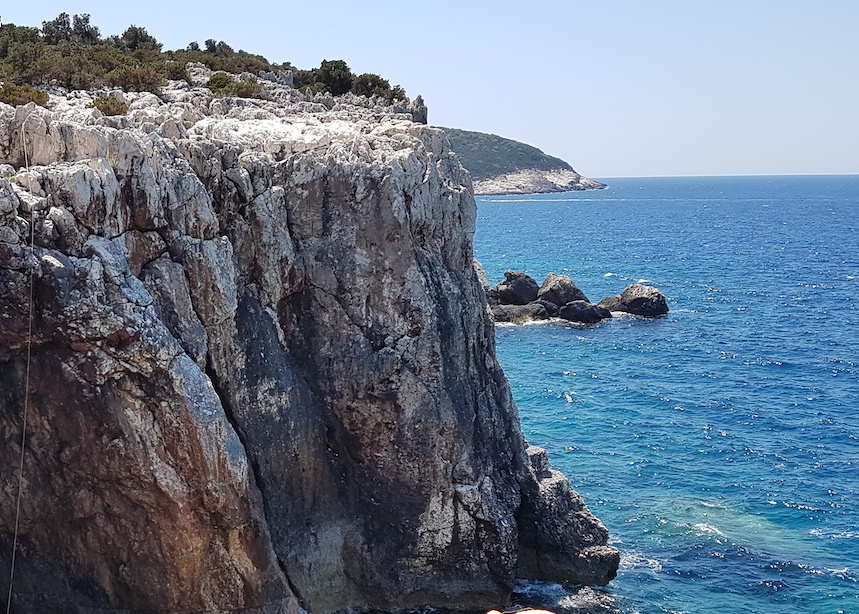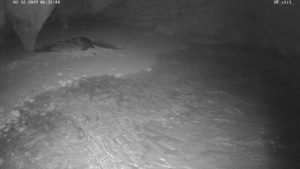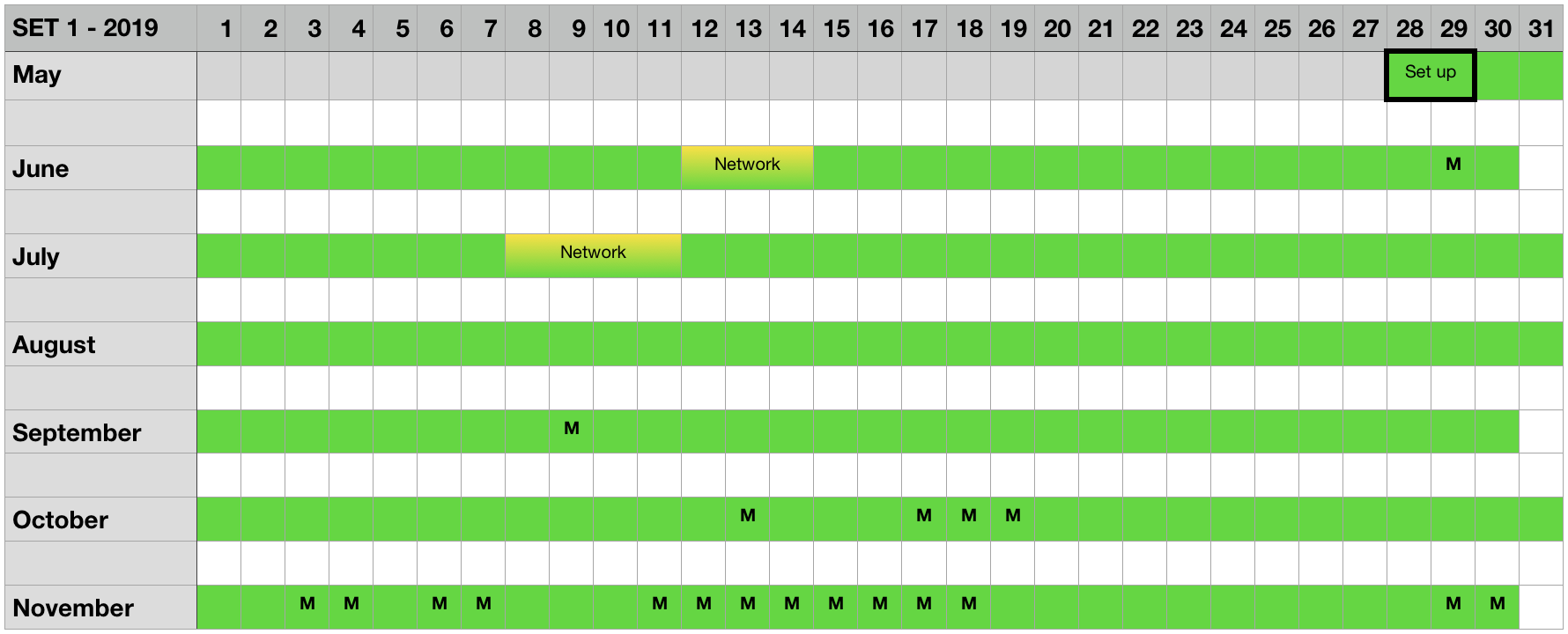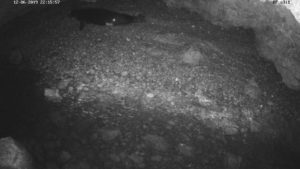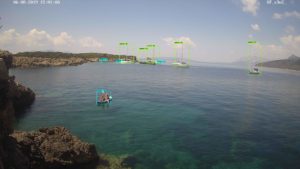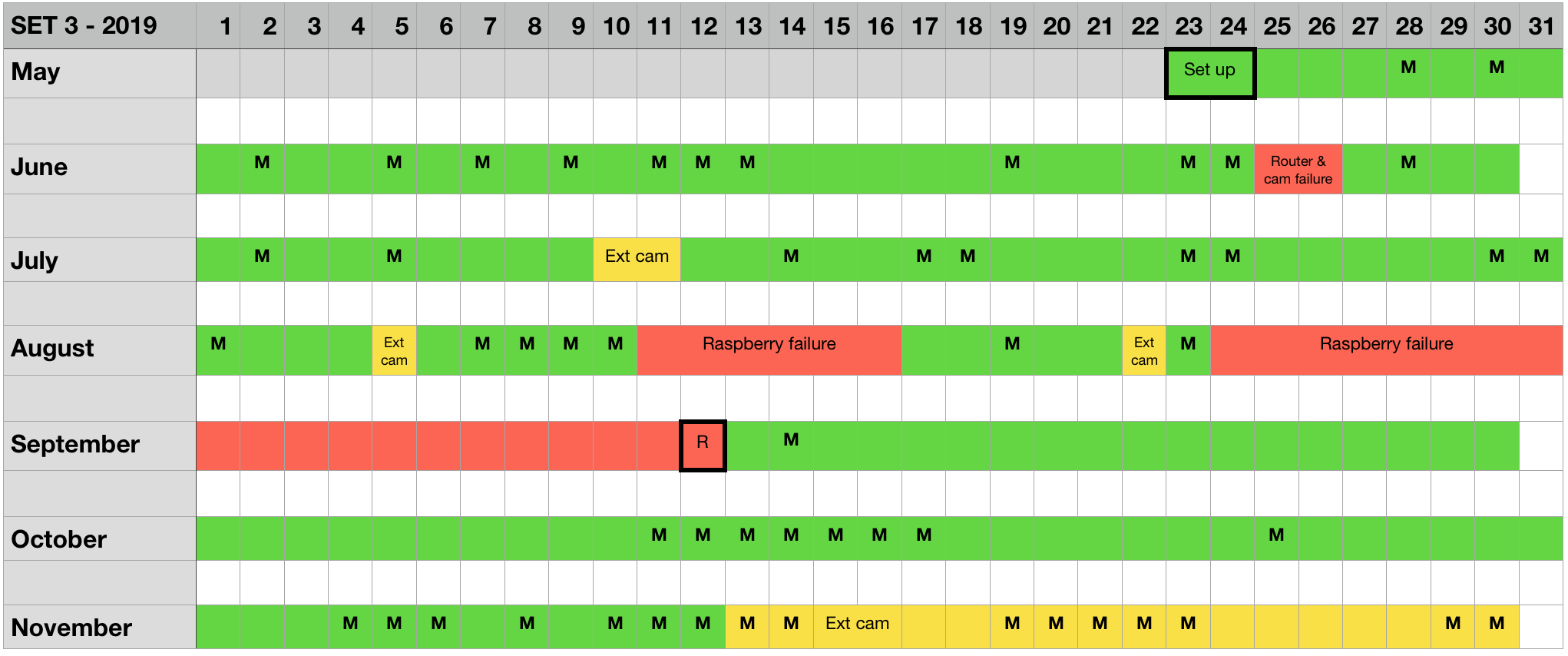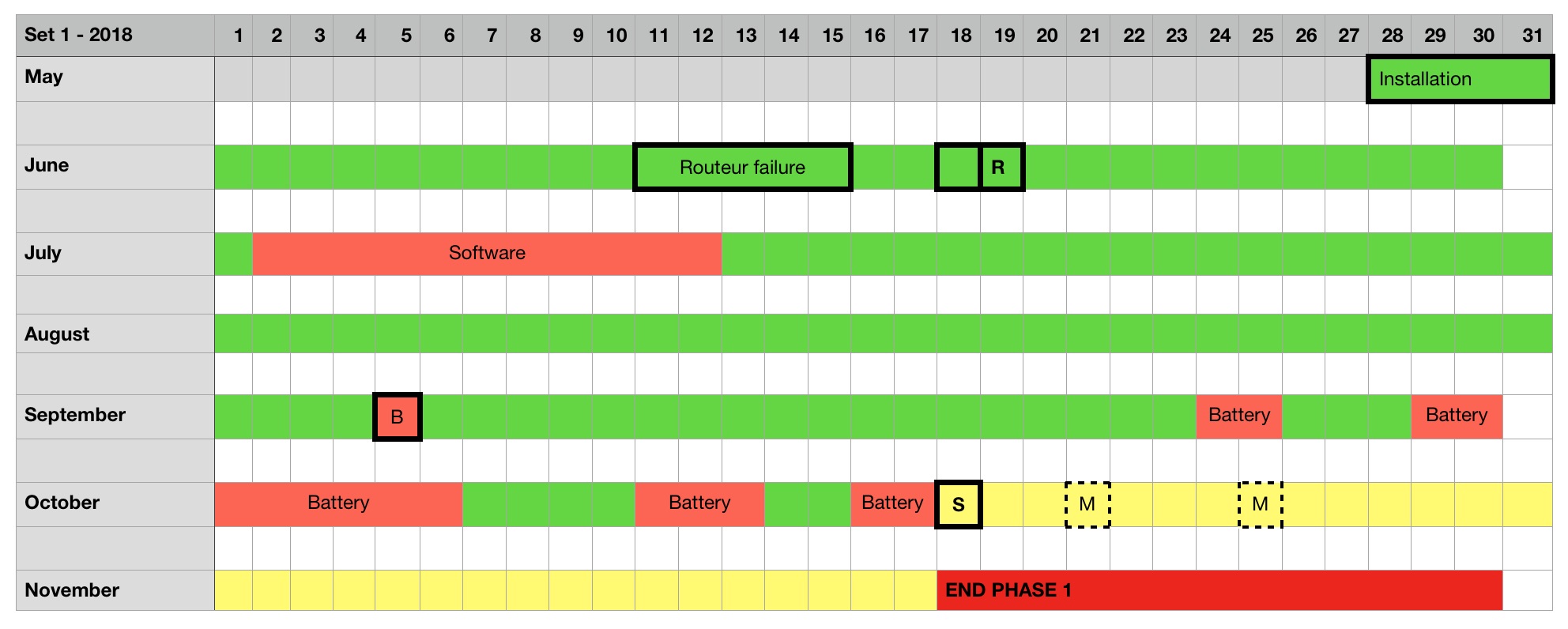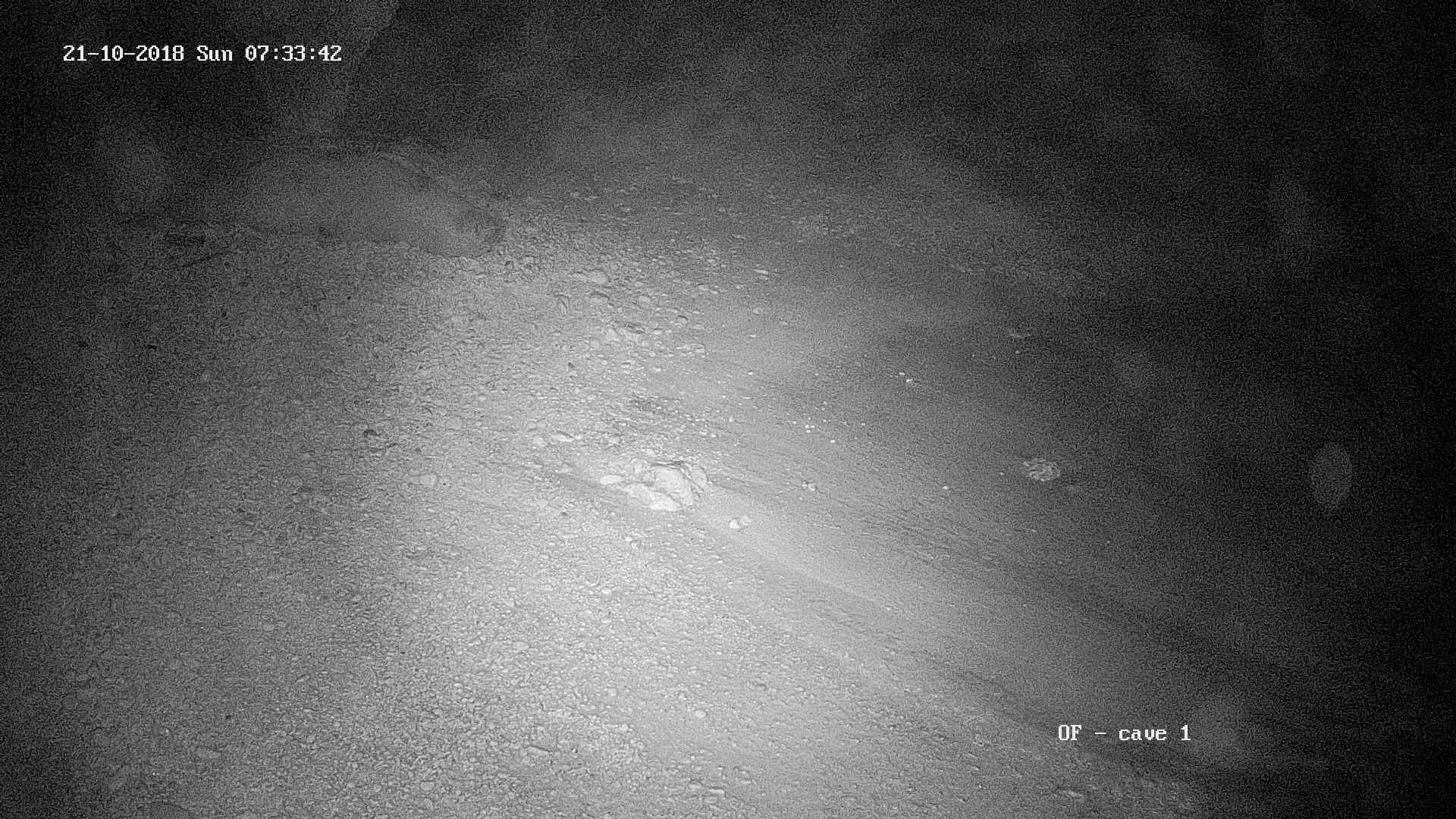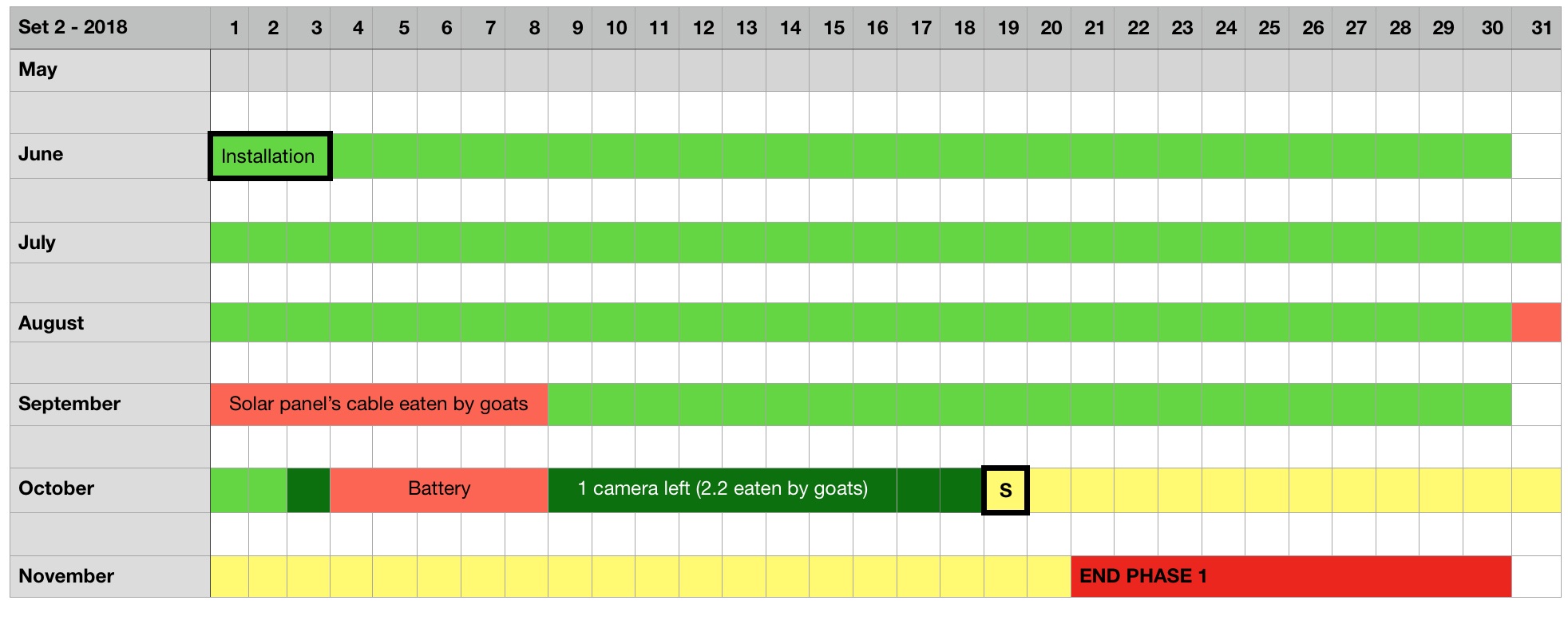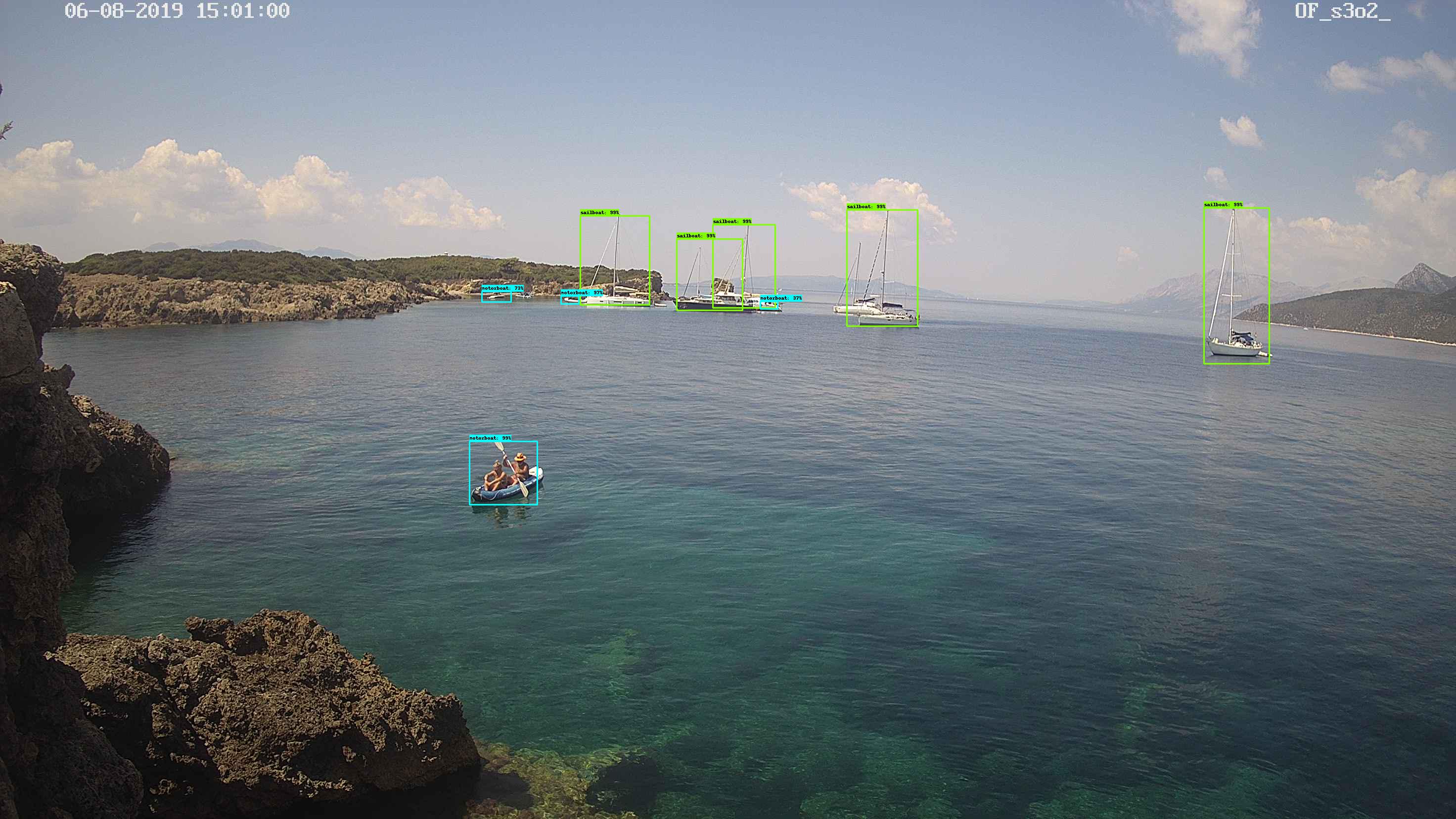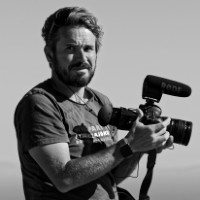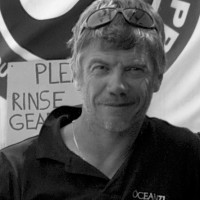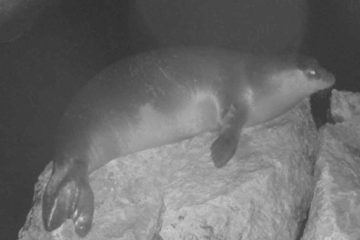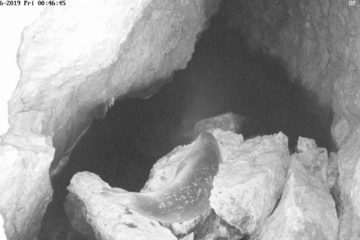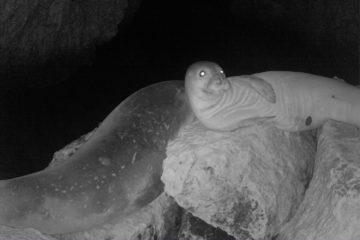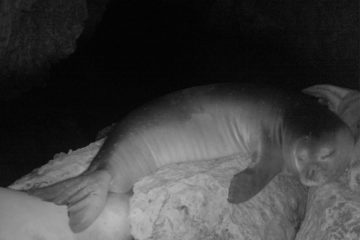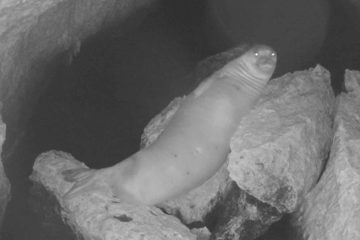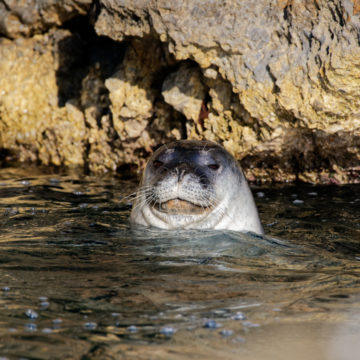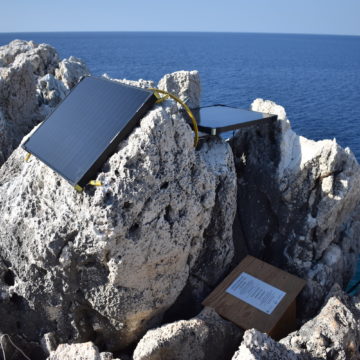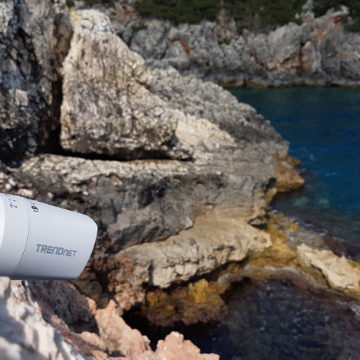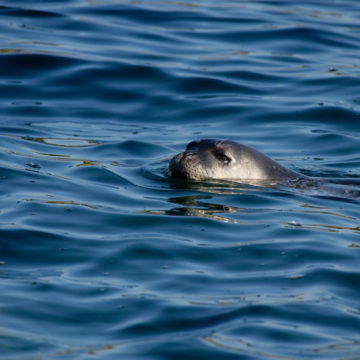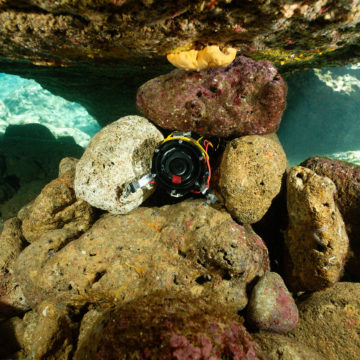

The Mediterranean Monk Seal (Greece, 2018 – 2022)
The Mediterranean monk seal is on the “endangered species” section of the IUCN’s red list since 1986. Its population is down to only a few hundred individuals, mainly concentrated in Greece and Turkey.
This marine mammal has been hunting in Mare Nostrum since the Antiquity. Yet, it’s still one of the least known and studied seals in the world. The Octopus Foundation joins a program aimed at better understanding this key species.
The monk seal is one of three emblematic marine species of the Mediterranean, alongside the grouper and the bluefin tuna. Unbeknown to most, thriving colonies of marine mammals could be found less than a century ago in most parts of the Mediterranean Sea, from Spain to Israel, from Northern Italy to Libya.
![]() Monachus monachus, the latin name of the Mediterranean monk seal, is today one of the most endangered marine mammals in the world according to recent reports by the IUCN (International Union for the Conservation of Nature).
Monachus monachus, the latin name of the Mediterranean monk seal, is today one of the most endangered marine mammals in the world according to recent reports by the IUCN (International Union for the Conservation of Nature).
Many reasons led to this critical situation. In Antiquity, they were relentlessly hunted for their skin and fat. During the 20th century, fishermen tried to get rid of an opportunistic competitor (seals damaged fishing nets). More recently, large scale tourism invaded most coastal areas where the marine mammals used to rest and give birth. The majority of these threatened animals have now been forced to hide in remote sea caves.
 For the most part, the scientific data for this species has been gathered and published in Greece in the last 20 years. Greece is one of the only countries where reproductive groups are studied all year round. Yet, recent sightings were confirmed in the Adriatic and Tyrrhenian Sea for example, suggesting a slow improvement of the species’ overall condition.
For the most part, the scientific data for this species has been gathered and published in Greece in the last 20 years. Greece is one of the only countries where reproductive groups are studied all year round. Yet, recent sightings were confirmed in the Adriatic and Tyrrhenian Sea for example, suggesting a slow improvement of the species’ overall condition.
Because of a geographic distribution that may be rapidly evolving, the IUCN wishes to launch and coordinate a project to bring together conservationists, scientists and the local population who live in areas visited by monk seals, such as diving centers, fishermen and skippers. They will all be asked to improve the knowledge on the threatened marine mammal.
The objective of this program is to find and develop accessible means (study tools, network of informants, raising of public’s awareness) to collect data in the entire Mediterranean basin, later to be shared between the stakeholders. It’s the best way to assess the precise situation of this species too often misunderstood yet vital for the survival of a healthy ecosystem.
Support to the IUCN and to various local actors
Mediterranean monk seals have been almost exclusively studied in Greece over the past 30 years. Confirmed sightings have nonetheless occurred in Turkey, Italy, Croatia and other countries. Unfortunately, it has proven particularly difficult to assess the species’ population as a whole. This information is crucial to understand the evolution of their numbers, and what targeted long-term efforts should be developed for their protection.
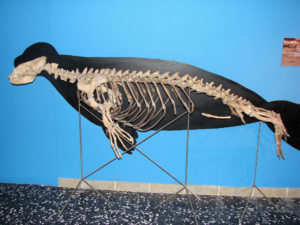 In order to paint a more accurate picture, the IUCN initiated and coordinates an international project, aimed at bringing together various field actors such as scientists, conservationists, fishermen and owners of diving centers. These actors are asked to collect data and share it with the other stakeholders, in order to evaluate the monk seal’s accurate geographic distribution.
In order to paint a more accurate picture, the IUCN initiated and coordinates an international project, aimed at bringing together various field actors such as scientists, conservationists, fishermen and owners of diving centers. These actors are asked to collect data and share it with the other stakeholders, in order to evaluate the monk seal’s accurate geographic distribution.
The Octopus Foundation works alongside the IUCN to offer biologists new affordable and open-source tools designed to improve the monitoring efforts in the entire Mediterranean basin. With a spirit of openness and sharing of information, the Octopus Foundation wishes for these tools to be used by as many scientists as possible, such as biologists studying beaches where turtles lay their eggs, or archeologists needing to monitor a sensitive site for example.
Existing monitoring tools
 For the past decades, marine biologists who have been studying monk seals in the Mediterranean have mostly relied on trigger cameras initially designed for hunters in forests. This kind of equipment has the main advantage of being cheap (200-500 euros per camera on average). As soon as an animal moves in front of the camera sensor, a picture or video is taken. The data is hence limited to the presence of an animal, simplifying the amount of data to be processed. Moreover, the set up of such an equipment is simple, considering the few electronic settings, the batteries (usually AA) and the volume of one camera to transport and install.
For the past decades, marine biologists who have been studying monk seals in the Mediterranean have mostly relied on trigger cameras initially designed for hunters in forests. This kind of equipment has the main advantage of being cheap (200-500 euros per camera on average). As soon as an animal moves in front of the camera sensor, a picture or video is taken. The data is hence limited to the presence of an animal, simplifying the amount of data to be processed. Moreover, the set up of such an equipment is simple, considering the few electronic settings, the batteries (usually AA) and the volume of one camera to transport and install.
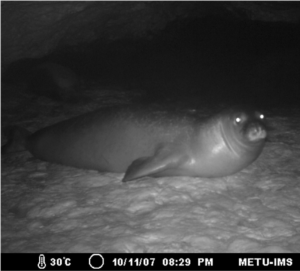 These devices also have disadvantages. Firstly, they only capture animals passing in the scope of the sensor. They don’t provide any context elements, such as the current weather and the human activity around the cave. Secondly, to retrieve the camera’s data (pictures and videos stored on an SD card), a person needs to enter the cave without knowing if an animal is present. Over a period of about 6 months, it is reasonable to consider two to three visits to retrieve the data and change the batteries that can be low after just a couple of weeks.
These devices also have disadvantages. Firstly, they only capture animals passing in the scope of the sensor. They don’t provide any context elements, such as the current weather and the human activity around the cave. Secondly, to retrieve the camera’s data (pictures and videos stored on an SD card), a person needs to enter the cave without knowing if an animal is present. Over a period of about 6 months, it is reasonable to consider two to three visits to retrieve the data and change the batteries that can be low after just a couple of weeks.
Also, these cameras are not designed to remain in a dark and highly humid environment such as marine caves. In these places favored by seals, humidity levels can reach 100% for several days or weeks in a row. It is then important to modify the small trigger camera to increase its tolerance to humidity.
Finally, the data is neither protected nor backed up against theft. If the camera is stolen (which is easy for such a compact device), or damaged, so is the recorded data for the past weeks or months.
New monitoring tools
The Octopus Foundation has developed and is currently testing several new observation tools to collect data. The autonomous monitoring kits and aerial drones are designed to complement the existing tools, and not replace them.
Autonomous monitoring kit
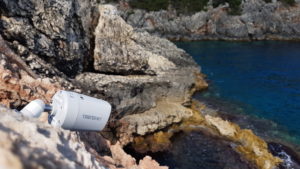 For this new monitoring tool, the Octopus Foundation assembled several prototypes from scratch, using « off the shelf » and « plug and play » elements. They were then tested in an area in Greece known for its monk seal activity.
For this new monitoring tool, the Octopus Foundation assembled several prototypes from scratch, using « off the shelf » and « plug and play » elements. They were then tested in an area in Greece known for its monk seal activity.
Each kit can monitor one cave and warn the biologists in real time if it’s occupied by a seal or not. These prototypes can also record the weather conditions, the surrounding human activity and other interesting animal activity. Connected to the local phone network through a 3G/4G router, the kit can transmit the data to a remote server, allowing the scientists to access the information from virtually anywhere in the world, and safely back it up.
Two to three years are necessary to test and improve the prototypes, in order to gather and process enough feedback.
The global budget for one autonomous monitoring kit (one cave) is of 2000 euros maximum.
Dynamic monitoring
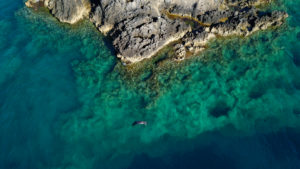 In addition to the continuous and autonomous monitoring of a cave, the Octopus Foundation offers to test recent affordable aerial drones as a tool to spot and follow monk seals in the vicinity of a cave. The idea is to test a drone relay in order to stay for approximately two hours in the air, and evaluate if seal identification can be done efficiently without disturbing them.
In addition to the continuous and autonomous monitoring of a cave, the Octopus Foundation offers to test recent affordable aerial drones as a tool to spot and follow monk seals in the vicinity of a cave. The idea is to test a drone relay in order to stay for approximately two hours in the air, and evaluate if seal identification can be done efficiently without disturbing them.
The global budget for one drone relay set (2 drones with 2 video-feedback) is under 4000 euros.
Following the Octopus Foundation’s open source philosophy, the choice of every tool and the step-by-step set-up are explained in the next pages.
October, 2021
Autonomous and open source monitoring kit
The analysis of previous experiences (cf. Gruppo Foca Monaca in Italy) proved the effectiveness of a time-lapse device (one picture is taken every 5, 10 or 15 minutes for example), when coupled with trigger cameras. The goal is to have a solar powered monitoring system that continuously records the seal activity inside and outside of a cave, the weather conditions and the human presence. The kit is connected to the local phone network via a 3G/4G router, in order to send the pictures to a secured server in the cloud.
Below is the design of the prototype, tested in Greek Ionian islands between 2018 and 2021:
And what it looks like in the field:
To receive a free guide to build and install your own monitoring kit, please click here.
Modules
There are a series of modules to consider in order to understand the whole kit:
-
- Solar energy
In recent years, solar technology has improved to the point where affordable equipment can now be found more or less anywhere around the planet. Usually, one or several solar panels charge one or several batteries, either lead or lithium based. Because of the significant price difference (almost simple to double) between lead and lithium based batteries, we limited the research to lead batteries that are also more easily found in remote places like an island or coastal area. Lead batteries are also less dangerous, as lithium can explode when the temperature is too high.
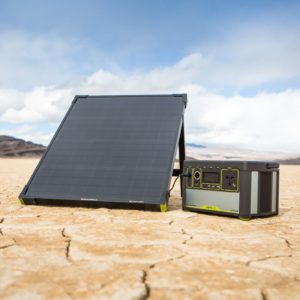 A fully autonomous system is by definition subject to theft. A carefully balance needs to be found between its price, efficiency, and power consumption.
A fully autonomous system is by definition subject to theft. A carefully balance needs to be found between its price, efficiency, and power consumption.
A given system may very well work year-round with a series of three solar panels and two batteries, but this would mean a sharp increase in value and exposition, therefore increasing the risk of theft. If the system can function with one solar panel (50 or 100 W for example) and one battery (a regular 12V car battery), then the loss remains financially limited and acceptable.
An additional parameter to take into account is the number of cycles that the battery can endure. Preference should be given to AGM batteries, designed to withstand a high number of cycles of charge and discharge, over a long period of time (minimum 6 months).
The solar panel and battery are linked via a charge controller. This important piece of equipment manages the energy input and output, in order to protect the battery from any kind of short circuit or other problems. It can also be set up to cut the output when the battery is running low, and turn it back on once a certain voltage is reached.
These three components are connected with basic electric cable, composed of two wires (positive and negative).
-
- Indoor/outdoor video monitoring
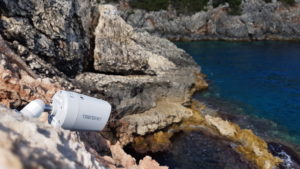 Two cameras are used in our configuration. One is installed outside near the entrance of a cave in order to monitor the surrounding events (including weather, and human activities which might be a disturbance for the animals). A second camera, located inside the cave near the beach, monitors seals that come to rest and/or give birth.
Two cameras are used in our configuration. One is installed outside near the entrance of a cave in order to monitor the surrounding events (including weather, and human activities which might be a disturbance for the animals). A second camera, located inside the cave near the beach, monitors seals that come to rest and/or give birth.
Both cameras work simultaneously, providing a full picture of the situation at a given moment. In this configuration (Mediterranean coastline), the outside camera is exposed to severe weather conditions (high temperature in summer and heavy rain for example) while the inside camera is constantly in complete darkness, with extreme levels of humidity over long periods of time.
In recent years, security is a field which developed dramatically in terms of technology. One key element is the use of « POE cameras » (meaning « Power Over Ethernet »), a relatively cheap kind of camera (between 100 and 300 Euros) that uses Ethernet cables to exchange both power and data. Two separate circuits are now irrelevant, which were often the source of many technical problems in the past.
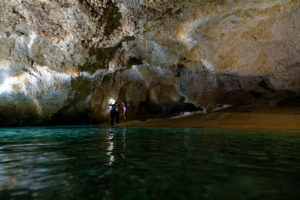 These POE cameras work up until a maximum of 100 meters from the control box.
These POE cameras work up until a maximum of 100 meters from the control box.
They are designed to provide security footage in and outside a building, day and night. Therefore, most of them are equipped with integrated infrared lights (with a usual range of up to 30 meters) and are at least IP66 (waterproof for heavy rain) if not IP67 (immersion waterproof).
-
- Time lapse monitoring
The goal is to have a continuous monitoring of the inside and the outside of a marine cave suitable for monk seals. The main problem with such a system is the amount of electricity required to power two video cameras with infrared lights. A key factor is to limit the consumption by switching on and off various elements. In our present situation, we know monk seals are incredibly fast and agile swimmers, but become slow and clumsy once on dry land. They often use a concealed beach to rest, allowing their observation over several hours or days.
Considering previous experiences in this specific field, we decided on a time lapse interval of 1 frame taken every 15 minutes (for each camera). Part of the system is thus powered up for two minutes (for the two cameras to have the time to boot properly), then a snapshot is taken from the video feed of each camera and recorded locally (USB key) and remotely (FTP server), before the system is switched back off to save energy. This cycle starts again every 15 minutes. Therefore, the cameras are powered on for a total of only 8 minutes every hour.
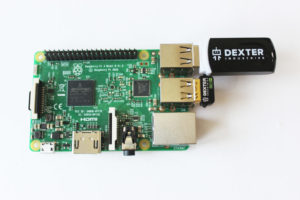 To manage that kind of automatic system, a very small and cheap micro computer the size of a credit card is available on the market : the Raspberry Pi (about 35 euros). It runs on 5V and can easily be programmed to manage simple tasks such as opening and closing an electric relay and recording data on a USB key.
To manage that kind of automatic system, a very small and cheap micro computer the size of a credit card is available on the market : the Raspberry Pi (about 35 euros). It runs on 5V and can easily be programmed to manage simple tasks such as opening and closing an electric relay and recording data on a USB key.
-
- Double backup
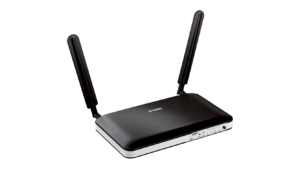 With this autonomous monitoring kit, the couple of photos are saved every 15 minutes on a local USB key. Via the router equipped with a SIM card, they are simultaneously sent to a remote FTP server that acts as an additional backup, for safety. This also allows the scientists to have a live feed of the cave’s interior, from virtually anywhere in the world. It is useful to assess if a seal is present or absent, in order to collect samples or retrieve the memory card of a trigger cam with the least possible disturbance.
With this autonomous monitoring kit, the couple of photos are saved every 15 minutes on a local USB key. Via the router equipped with a SIM card, they are simultaneously sent to a remote FTP server that acts as an additional backup, for safety. This also allows the scientists to have a live feed of the cave’s interior, from virtually anywhere in the world. It is useful to assess if a seal is present or absent, in order to collect samples or retrieve the memory card of a trigger cam with the least possible disturbance.
If, for any reason at all, the local phone network crashes (which actually happens quite often), the pictures are still recorded locally on a USB key. The memory key and microcomputer can be retrieved by a local contact in the electronic box without having to physically enter the cave and possibly disturb the animals.
-
- Software
The tasks of powering the cameras on and off, and saving the images to the USB key before sending them to the FTP server are managed through a software (Python script) that can be modified to fit every situation. The software can be downloaded by scientists who wish to use the kit, please write us an email.
To further facilitate the use of this system, we propose to fully set up a Raspberry Pi according to the needs, and send it via post anywhere in the world.
-
- Cave monitoring box
This box was designed in marine plywood (that can be found in most coastal regions), and covered with three layers of varnish. Ideally, the edges are covered in epoxy resin. The screw holes are outside the box to prevent water infiltration. Ventilation plates on the sides can be removed and replaced by full wood plates in the fall and winter when temperature drops. The dimensions are in millimeters.
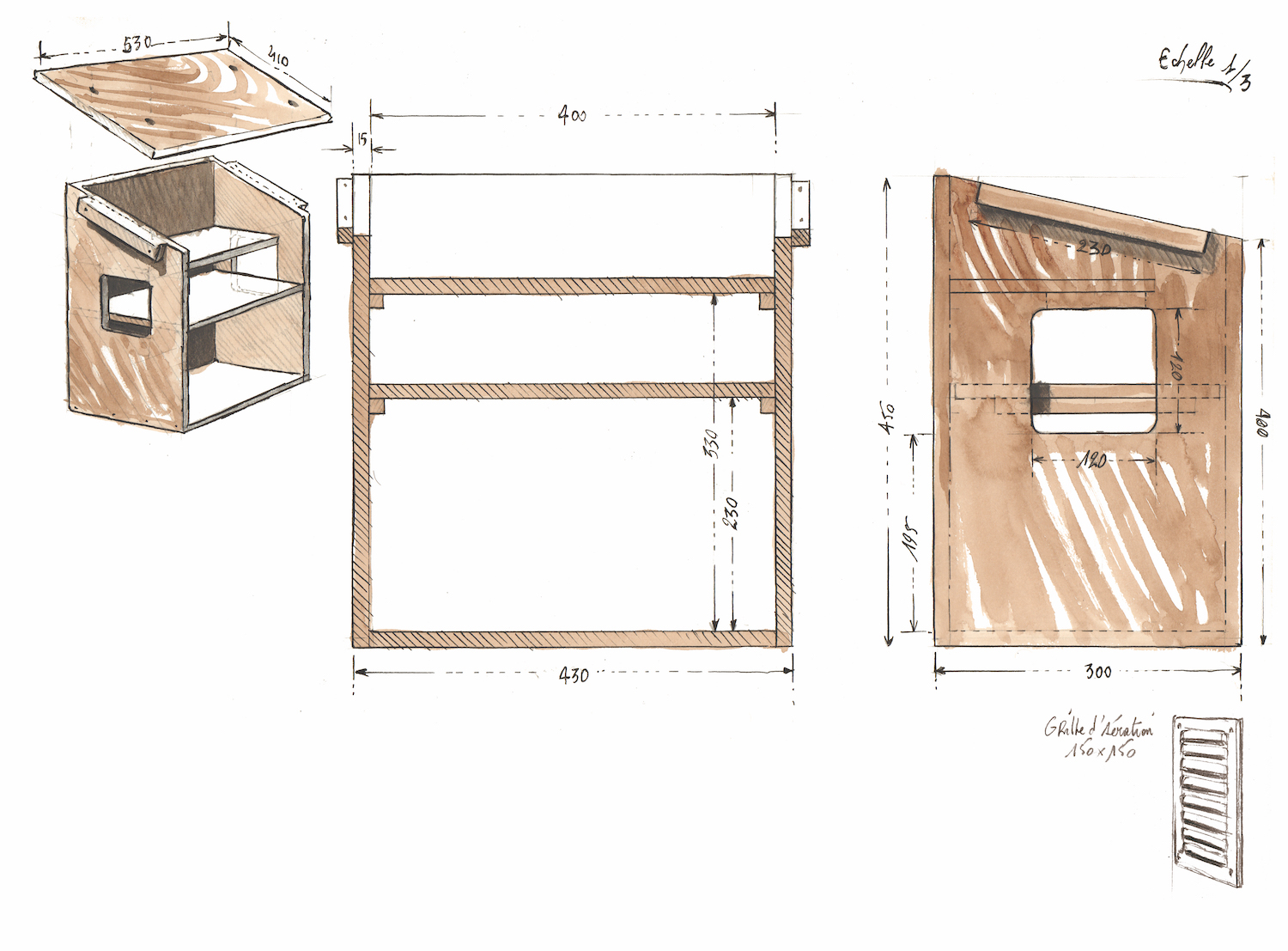
-
- Underwater camera
 In 2019, the discovery of a fully submerged cave from which several seals emerged prompted us to consider adding an underwater module to our system.
In 2019, the discovery of a fully submerged cave from which several seals emerged prompted us to consider adding an underwater module to our system.
Its installation in 2020 was crowned with success: during more than two weeks hundreds of photos of seals swimming and sleeping in the water were recorded, as well as several videos.
For this conclusive experiment, we took the exact same model of POE camera (Trendnet TV-IP316PI) that is usually installed in caves and on cliffs. We had to modify it slightly, by outsourcing the infrared LEDs and removing the fixation and the cap from the camera.
Everything was then inserted into a waterproof case from the American brand Blue Robotics.
In 2021, the underwater housing was upgraded with special cable glands. This improved the waterproofing, which allowed the underwater camera to keep recording for more than 4 continous months and providing us with an unprecedented database.
-
- Additional sensors (experimental device)
In 2021, an experimental device was installed alongside the camera above the beach of Site 4: the sensor module.
 It’s a completely seperate Rapsberry Pi, in its own waterproof housing, which can operate any kind of sensors. For this first experiment, we decided to focus on a microphone, a temperature and humidity sensor and a water temperature sensor.
It’s a completely seperate Rapsberry Pi, in its own waterproof housing, which can operate any kind of sensors. For this first experiment, we decided to focus on a microphone, a temperature and humidity sensor and a water temperature sensor.
Unfortunately, the water temp device malfunctionned shortly after installation. But the microphone and other sensors have been working tirelessly for more than 4 months.
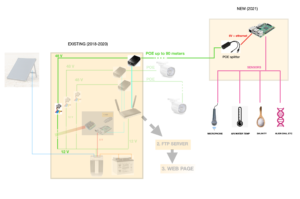 These sensors can be accessed at anytime and from anywhere in the world, since the Raspberry Pi is also powered over the Ethernet and connected to the router of the electronic box.
These sensors can be accessed at anytime and from anywhere in the world, since the Raspberry Pi is also powered over the Ethernet and connected to the router of the electronic box.
The downside is that it’s an additional device that uses energy from the battery and solar panel, and thus we expect this site to be more rapidly offline in case of lack of sun in the winter months.
2018 field mission: SET 1 and SET 2
For phase one of testing (2018), two prototypes were installed in two distinctive caves in Greece that were chosen for their geomorphological differences.
The goal for this phase was to make both systems work for 6 months in order to test the various components. Installed at the beginning of June, they were designed to last until the end of November. These two prototypes were put together with affordable plug-and-play elements (maximum 2000 euros for one kit).
-
- SET 1
The first prototype was installed in a cave known for quite a long time by the local marine biologists to be a place where seals come to either rest and/or give birth.
The cave is located at the foot of a steep rocky cliff of about 20-25 meter high, which falls vertically in the water. At about one meter deep, there is a passage, allowing seals to easily swim in the cave. Once in, there is still water for about 50 meters before reaching at the far end a large dry beach of about 30 meter wide.
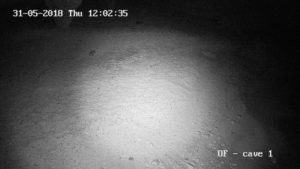 Outside, on the left of this underwater entrance, big parts of the cliff have fallen down, opening a large terrestrial entrance.
Outside, on the left of this underwater entrance, big parts of the cliff have fallen down, opening a large terrestrial entrance.
The entrance is generally oriented North, exposing this coastal part to the Summer dominant North-Western breeze. The outside camera on top of the cliff also points to the North with the sun on its back, providing images with a excellent exposure throughout the entire day.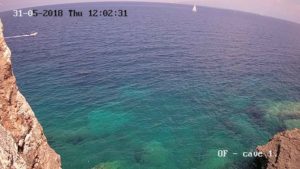
At the beginning of June 2018, the electronic box of SET 1 was installed in a rock cavity at the top of the cliff, the solar panel wedged in between two rocks above the box and the cameras screwed both on top of the cliff and down in the cave (with a 90m long Ethernet cable).
Apart from small settings such as over or under exposure on some pictures, the entire process was functioning perfectly, with one picture by camera being taken every 15 minutes, 24/7.
-
- SET 2
For various technical reasons, we could not install a similar configuration in another cave. So, we decided to use two of our remaining Ethernet cables (20 and 10 meters long) to monitor a cave with a totally different configuration, in order to test the limits of each module of the same system.
During our scouting missions in previous years, we were told about a “crack” in the coast that was sometimes occupied by monk seals. Compared to the location of SET 1, it has the specificity to be along a low on water part of the coast and exposed to the South. Also, this cave is fully submerged by water. Most probably, at the far end of the cave, there is a pocket of air that allows seals to breath. In any case, the operation to fully submerge and install an Ethernet cable with a camera, which are not totally waterproof (IP66), was too risky at this stage of the tests.
We installed the second prototype with two exterior cameras around the entrance of the cave, looking in different directions. Knowing that there was almost no chance to photograph a seal swimming in the water (they are too fast), we focused on the environmental data (weather and human activity). This configuration is a good way of testing the angle of the cameras, as those of SET 2 are looking south (180°) and South East (110°). It provided us with interesting information on how they react to a facing sun at different moments during the day.
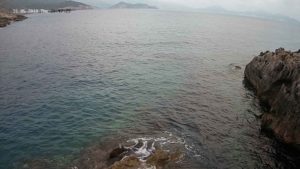 As the two cameras of SET 2 are outside, it was useless to let them run during the night as infrared light don’t work with a moving object such as the sea. We changed the software settings, to only power the cameras from 5 am to 10 pm (from 1st June to 17th of October). On the 18th of October, we changed it once again to switch on from 7 am to 8 pm, to follow the rapidly diminishing sun exposition.
As the two cameras of SET 2 are outside, it was useless to let them run during the night as infrared light don’t work with a moving object such as the sea. We changed the software settings, to only power the cameras from 5 am to 10 pm (from 1st June to 17th of October). On the 18th of October, we changed it once again to switch on from 7 am to 8 pm, to follow the rapidly diminishing sun exposition.
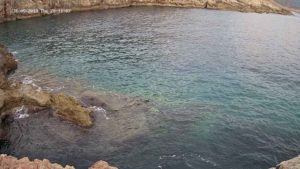 As SET 2 was operating for less hours than SET 1 (17h/24 h originally instead of 24h/24 h), we also changed the time interval, again to test the limits of each module of the system (battery, Raspberry Pi, relays, etc.). The new time interval was set to every 10 minutes instead of every 15 minutes, increasing the chances – even very slightly – to photograph an animal that would breath on the surface near the entrance of the cave. But the goal was also to remain at about the same amount of data sent through the 3G/4G router So, on 24h, when SET 1 was taking a total of 192 pictures, SET 2 would take a total of 204 pictures. Our telephone plan for our data-only SIM card was 3GO per month for 30 euros, which was enough considering each photo sent from our kit was of maximum 300 KO.
As SET 2 was operating for less hours than SET 1 (17h/24 h originally instead of 24h/24 h), we also changed the time interval, again to test the limits of each module of the system (battery, Raspberry Pi, relays, etc.). The new time interval was set to every 10 minutes instead of every 15 minutes, increasing the chances – even very slightly – to photograph an animal that would breath on the surface near the entrance of the cave. But the goal was also to remain at about the same amount of data sent through the 3G/4G router So, on 24h, when SET 1 was taking a total of 192 pictures, SET 2 would take a total of 204 pictures. Our telephone plan for our data-only SIM card was 3GO per month for 30 euros, which was enough considering each photo sent from our kit was of maximum 300 KO.
For the rest of the configuration, the electronic box was installed under a small tree (to test the sun protection of a tree compared to the rocky situation of SET 1), the solar panel was wedged between the rocks on a steeper slope (looking 160° at about 20° of slope), the Ethernet cables ran through the rocks enclosed in an old water hose, and the cameras were screwed around the entrance of the cave, way closer to the sea than those of SET 1. Both of them are at about 5 meters above sea level. This configuration will show how these cameras resist the waves during storms with Southern winds that can be particularly strong on this stretch of coast.
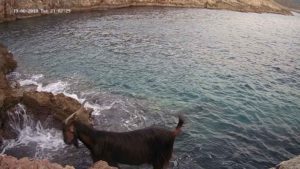 An interesting fact to note is the presence of large herds of goats in this particular area. We realized it during the installation. For SET 2, most cables (2 Ethernet cables and 1 solar panel cable) were protected by an old water hose. At first, we imagined that these animals could damage the cables by stepping on them with their sharp hooves. We later realized that the goats rather enjoy chewing the electric cables if they are apparent. On the contrary, if the electric cables are well covered by the water hose, the goats can’t damage them.
An interesting fact to note is the presence of large herds of goats in this particular area. We realized it during the installation. For SET 2, most cables (2 Ethernet cables and 1 solar panel cable) were protected by an old water hose. At first, we imagined that these animals could damage the cables by stepping on them with their sharp hooves. We later realized that the goats rather enjoy chewing the electric cables if they are apparent. On the contrary, if the electric cables are well covered by the water hose, the goats can’t damage them.
2019 field mission: Installation of SET 3, upgrade of SET 1 and SET 2
For phase two of testing (2019), a third prototype was installed in Greece in a new cave that was chosen for its geomorphological particularities. We also decided to upgrade the first two sets with better performing modules.
-
- Installation of SET 3
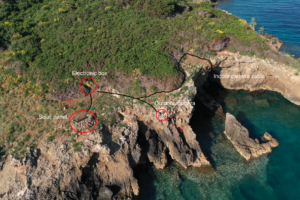 The third prototype was installed on a isolated and desert island, many kilometers away from the first town. For the past years, this marine paradise has had the reputation of sheltering a number of monk seals all year round.
The third prototype was installed on a isolated and desert island, many kilometers away from the first town. For the past years, this marine paradise has had the reputation of sheltering a number of monk seals all year round.
While SET 1 & 2 can be accessed by car and foot, SET 3 requires the use of a boat. The anchorage on the sharp rocks is particularly risky. The isolation allows SET 3 to lower the risk of theft or damage. It also means that it is harder and less convenient for a team to perform modifications, repair and/or retrieval.
The entrance is generally oriented North, exposing this coastal part to the Summer dominant North-Western breeze. The outside camera also points to the North with the sun on its back, providing images with an excellent exposure throughout the entire day.
A 70-meter-long Ethernet cable was deployed to reach the end of the cave, where the inside camera was facing the beach where seals seem to rest mostly at night.
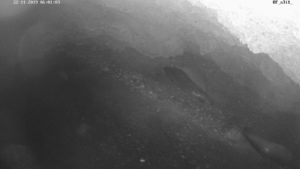 There are no trees nor tall rocks to protect the control box from the harsh Greek sun rays. The modules will be under a lot heath stress during the summer.
There are no trees nor tall rocks to protect the control box from the harsh Greek sun rays. The modules will be under a lot heath stress during the summer.
There are no goats on this particular uninhabited island, yet we still protected all the apparent cables with garden hose, in case there were some sort of rodent. It’s with birds that we experienced some problems this time, as the secluded island is favorable for marine species to nest. The solar panel was soon covered in droppings, and the field team had to regularly clean it during the first half of summer. During the second half, there seemed to have no change in bird population, yet the solar panel needed much less cleaning.
-
- Update SET 1
 Back on location of SET 1, we decided to upgrade the inside camera in order to increase the picture’s resolution, and cover a larger portion of the beach with a improved infrared beam.
Back on location of SET 1, we decided to upgrade the inside camera in order to increase the picture’s resolution, and cover a larger portion of the beach with a improved infrared beam.
A brand new AGM battery with larger capacity was also installed in the control box, alongside an efficient charge controller that manages the output depending on the battery’s state of charge.
-
- Update SET 2
The updates brought to the SET 1 were also brought to the SET 2, with more recent cameras, larger capacity battery and efficient charge controller.
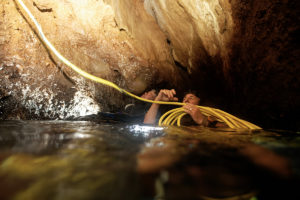 After studying the “crack’s” surroundings with care, the field team found a vent that connects one of the marine cave’s chambers with the exterior. After a team of professional went diving in the cave to scout the surroundings and make measurements, it was decided to install a camera a the end of the cave which seems to be often used by monk seals.
After studying the “crack’s” surroundings with care, the field team found a vent that connects one of the marine cave’s chambers with the exterior. After a team of professional went diving in the cave to scout the surroundings and make measurements, it was decided to install a camera a the end of the cave which seems to be often used by monk seals.
 A large section of the cave is fully underwater, which meant we had to waterproof the IP67 surveillance camera. After several days of effort, the far end of the marine cave was finally monitored by our new camera. Less than 24 hours after installation, a monk seal was photographed by our device.
A large section of the cave is fully underwater, which meant we had to waterproof the IP67 surveillance camera. After several days of effort, the far end of the marine cave was finally monitored by our new camera. Less than 24 hours after installation, a monk seal was photographed by our device.
Unlike 2018, we calibrated the SET 2 time lapse settings so that it matches the ones from SET 1 & 3, which is a pair of photo every 15 minutes, 24/7.
At the beginning of June 2019, for the first time, 6 cameras were successfully monitoring 3 different marine caves.
2020 Field mission: Installation SET 4, and upgrade SET 1, 2 and 3
For phase 3 of our tests (2020), a fourth prototype was installed in Greece in a new cave with different geomorphological conditions from the first three sets. We also took advantage of this new mission to improve SETS 1, 2 & 3 with various new modules. Several experimental modules have also been installed in the field.
-
- Installation of SET 4
 The fourth prototype was installed on a deserted and isolated island, miles from the closest town. Over the years, the Octopus Foundation team has encountered many monk seals in the area.
The fourth prototype was installed on a deserted and isolated island, miles from the closest town. Over the years, the Octopus Foundation team has encountered many monk seals in the area.
While SETS 1 & 2 can be reached on foot or by car, SET 4 can only be accessed by boat. Mooring to sharp rocks is particularly dangerous. Due to this isolation, SET 4 may be less prone to theft and / or damage. The downside is that it is more difficult to access to make repairs or modifications.
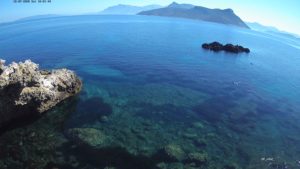 The entrance to the cave faces North, thus exposing it to the prevailing summer winds that blow from the North/North-West sector. The exterior camera is therefore also oriented to the North, thus optimizing the exposure of exterior photos throughout the day.
The entrance to the cave faces North, thus exposing it to the prevailing summer winds that blow from the North/North-West sector. The exterior camera is therefore also oriented to the North, thus optimizing the exposure of exterior photos throughout the day.
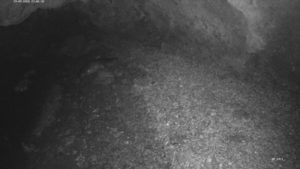 An Ethernet cable of about 40 meters is sufficient to install a camera at the bottom of the cave, oriented towards the inner beach where seals mainly rest at night. There are no goats on this island, but the exposed cables were still protected with a garden hose in case any rodents get too keen. However, this desert island serves as a nesting hotspot for hundreds of birds. The numerous droppings quickly covered a not insignificant part of the solar panel.
An Ethernet cable of about 40 meters is sufficient to install a camera at the bottom of the cave, oriented towards the inner beach where seals mainly rest at night. There are no goats on this island, but the exposed cables were still protected with a garden hose in case any rodents get too keen. However, this desert island serves as a nesting hotspot for hundreds of birds. The numerous droppings quickly covered a not insignificant part of the solar panel.
-
- Update SET 1
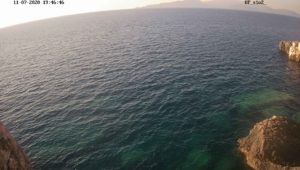 Back in the cave where SET 1 was originally set up in 2018, we replaced the indoor camera and its 90m Ethernet cable which had not survived the winter. The outdoor camera has also been replaced by a new model. It should be noted that this was the TV-IP314PI model, in place since 2018. The new model is the TV-IP316PI. Finally, in order to start fresh for the months or years to come, a brand new router and Raspberry Pi were connected in the box.
Back in the cave where SET 1 was originally set up in 2018, we replaced the indoor camera and its 90m Ethernet cable which had not survived the winter. The outdoor camera has also been replaced by a new model. It should be noted that this was the TV-IP314PI model, in place since 2018. The new model is the TV-IP316PI. Finally, in order to start fresh for the months or years to come, a brand new router and Raspberry Pi were connected in the box.
-
- Update SET 2
The updates made on SET 1 were also made on SET 2, such as a new router and Raspberry Pi. The outdoor camera was still functional, but it was still the TV-IP314PI from 2018. It has been replaced by a TV-IP316PI.
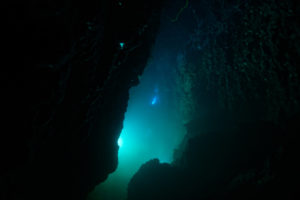 As for the interior camera, it had not withstood a swell of November 2019. We have the images of its destruction by a wave. It has logically been replaced, with a brand new cable of around 70 meters.
As for the interior camera, it had not withstood a swell of November 2019. We have the images of its destruction by a wave. It has logically been replaced, with a brand new cable of around 70 meters.
Once again, a team of divers ventured into this intimidating cave for installation.
-
- Update SET 3
Again, a brand new router and Raspberry Pi were added to the existing hardware of the SET 3. The outdoor camera had not withstood the winter weather, so it was replaced by a new model.
Regarding the interior camera, it was moved to a better position inthe cave, to get closer to the privileged resting site. The aim is to capture better quality images, which can help us identify animals by their coat markings.
2021 Field mission: Installation of SET 5, and upgrade SET 1, 2, 3 and 4
For phase 4 of our tests (2021), a fifth prototype was installed in Greece in a new cave with different geomorphological conditions from the first four sets. We also took advantage of this new mission to improve SETS 1, 2, 3 & 4 with various new modules. Several experimental modules have also been installed in the field.
-
- Installation of SET 5
The fifth prototype was installed on a deserted and isolated island, miles from the closest town. Its rugged coastline is very exposed to prevailing winds, which had prevented us from accessing this particular cave in 2020.
In 2021, we took advantage of a few days of calm weather to install this fifth system.
SET 5 can only be accessed by boat. Mooring to sharp rocks is particularly dangerous. Due to this isolation, we hope that SET 5 will never be stolen or intentionally damaged. The downside is that it is more difficult to access to make repairs or modifications.
The entrance to the cave faces North, thus exposing it to the prevailing summer winds that blow from the North/North-West sector. The key difficulty was to find an appropriate place for the solar panel, as there are very few flat surfaces and a big cliff nearby that blocks the sun most of the morning.
An Ethernet cable of about 90 meters was needed to install a camera at the bottom of the cave, oriented towards the inner beach where seals rest and give birth. There probably are animals on this island, so all of the exposed cables were protected with garden hose or plastic corrugated tube
-
- Update SET 1
Back in the cave where SET 1 was originally set up in 2018, we installed a new exterior camera as the old one didn’t survive the winter. One of the step-ups was also too corroded so we changed it for a new one. In order to start fresh, a new Raspberry Pi and relay board replaced the existing one alongside a new step-down.
-
- Update SET 2
The interior camera and its cable had only worked for a few weeks in 2020. Better connections and protections were installed. This time, the whole 70m long Ethernet cable was protected with a flexible corrugated tube made of strong plastic.
Once again, a team of divers ventured into this intimidating cave for installation.
In the electronic box, a new 12v battery had to replace the old one that had not been charged in several months (the cable from solar panel had been cut by an animal in the winter). A new Raspberry Pi, relay board, step-down and router are also installed as SET 2 had been salvaged in the winter to try and repair SET 1.
-
- Update SET 3
SET 3 was mainly equipped with a new underwater camera, with an improved waterproofing since last year where it only lasted for 2 weeks.
A new Raspberry Pi, relay board, step-down and router are installed in the electronic box.
-
- Update SET 4
The main update for SET 4 is the installation of a new device, the sensor kit. It’s a completely separate Raspberry Pi, in its own waterproof housing.
This device can record sounds with its microphone, as well as air temperature and humidity.
The Raspberry is powered over the Ethernet, which means it also has a dedicated step-up and injector in the electronic box. These are always powered on and are using electricity from the same battery and solar panel as the rest of SET 4.
For SET 4, a new Raspberry Pi, relay board, step-down and router are installed.
Dynamic monitoring
With the current improvement of Lithium-Ion battery technology, the general public “quadcopter” drones can now fly for almost 30 minutes with a single battery. First in Switzerland, and later in Greece, the drone pilots of the Octopus Foundation tested a protocol of relaying drones in order to stay for up to two hours in the sky looking down.
The goal is to find and follow monk seals that swim in shallow waters, next to a marine cave. The protocol is designed to allow two pilots to relay each other, without colliding and without loosing sight of the marine mammals.
For phase 1 of our tests, (2018), while flying at several dozen meters above the surface of the sea, monk seals were spotted and filmed with this method. The drones have serious advantages: for less than 2000 euros a piece, they can fly to a maximum of 6km and have 25 minutes of autonomy, while being sufficiently quiet (less than 60db) to follow seals without apparently disturbing them in any way in their daily activities.
In 2019, here are the drone models we used:
DJI Mavic 2 Pro, with Crystal Sky 7,85 »
DJI Mavic 2 Zoom, with Crystal Sky 5,5 »
October, 2021
Autonomous and open source monitoring kit
2020 results
Still being processed
2019 key results
A Master Thesis has been published at the Scottish Oceans Institute of the University of St Andrews, based on the data collected in 2019.
The data collected in 2019 allowed the Octopus Foundation to identify 10 different monk seals.
In December of 2019, the Octopus Foundation presented a scientific poster at the World marine mammal conference in Barcelona.
SET 1, 2019
For the 6 month test period of 2019, from June 1st to November 30th, SET 1 was online 100% of the time.
A few holes in the monitoring occurred after power outages impacted the local phone network. Luckily, as designed, we were able to retrieve the missing pictures on the local USB key.
The outside camera was able to monitor the local boat traffic, human presence next to the cave, as well as storms and outstanding meteorological events.
The inside camera photographed many seals, particularly since the month of October (the boxes marqued “M” on the below chart mean monk seal presence on at least one photo over 24 hours).
It is interesting to note that this system is still working through December, and will probably keep providing us with photos all across winter, as long as the battery withstands the inevitable diminished solar cover.
SET 2, 2019
In 2019, SET 2 proved to be our main source of satisfaction and frustration.
Over time, we realized that this site was particularly enjoyed by many different individuals. More than 6’000 pictures of seals were taken in this cave alone, over the 6-month-test period.
On the downside, we underestimated the level of protection needed by the Ethernet cable that was submerged in water, between two pockets of air. At the end of June, the cable was badly damaged (after finding teeth marks on it, we concluded that a too curious seal took a bite), meaning the loss of the inside camera during 11 days.
A team was sent on location at the beginning of July to retrieve the broken cable, and install a new one with a better designed protection.
Unfortunately, on November 4th, a few weeks before the end of the test period, a particularly powerful storm sent huge waves aimed directly at the enter of the cave. The massive water movement damaged our material. Once again, we lost the inside monitoring. Our local team having left for the winter, we had nobody to repair the system.
Nevertheless, we are particularly satisfied with the data produced by SET 2, that ended up working for 82% of the test period.
SET 3, 2019
Although SET 3 produced great results in 2019, the overall picture is a little beneath what SET 1 & 2 were able to achieve, both in terms of percentage (76% of the test period) and photos of monk seals.
We realized that the beach at the end of this cave was hardly ever occupied by seals, although we know that many animals were in this area throughout the whole test period.
One of this year’s highlight was the identification of a large male, which was photographed at the SET 3 and ten days later was photographed inside the cave monitored by SET 2. Several dozens of kilometers separate these two sites.
The main advantage of SET 3 is its outside camera, aimed at a very popular mooring. This allowed us to precisely quantify the presence of boats and humans in a very close vicinity of a monk seal marine cave.
All in all, the modules of SET 3 worked rather well, except the Raspberry Pi which unexpectedly malfunctioned on the 24th of August. It was subsequently replaced on the 13th of September by a brand new model, which never posed any new problems.
Nevertheless, we ended up with a pretty large hole between the end of August and the beginning of September, which is explained by the fact that SET 3 is logistically difficult to reach by our local team. While SET 1 & 2 can be repaired by a team on foot and by car, SET 3 can only by accessed by a team with a boat.
Mid November, the exterior camera unfortunately stopped working. It was probably damaged by the extreme humidity. Its Ingress Protection code is IP67, meaning it’s not 100% waterproof. We’ll be able to analyze it in 2020 when we’ll retrieve it, and replace it by a new model.
CONCLUSION for 2019
This second test period took place in 2019, and produced outstanding results, both from a technical point of view and from the monitoring of monk seals and human activity around three marine caves.
The three systems took a total of more than 100’000 pictures over a 6 month period. These second generation prototypes recorded successfully some 8’600 pictures with monk seals, taken by five of our six deployed cameras. Some of these photos have allowed the identification of individuals, by outlining their size and various body marks. This identification will be improved during the third season, by moving the cameras closer to where the seals rest in the caves.
Overall, we experienced a small number of technical problems. All of them were relatively rapidly addressed by our field partners. We wish to warmly thank the teams of the Ionian Dolphin Project, Kozamare, Fiskardo Divers and Odyssey Outdoor Activities.
Despite minor problems, the various modules that compose our open source and autonomous system proved to be resilient enough to survive many months, or years, in harsh conditions with high temperature and extreme levels of humidity such as those found around the Mediterranean Sea.
2018 results
SET 1, 2018
The first phase yielded promising results, with a functioning system in harsh Mediterranean situation. On a total of 174 days, the SET 1 has successfully recorded photos during 148 days (85%).
Most of the time, the “off” days came from a low battery which subsequently switched off the power, waiting for the solar panel to recharge. Unfortunately, when this happened, a person had to physically walk all the way to the control box to switch the system back on by pressing two buttons. It happened that the power consumption was higher than the production (weak solar exposition, several days of bad weather, solar panel with an inappropriate orientation, etc). We also experienced a software bug on (July 2nd), a router failure (replaced on July 15th) and various technical situations that were solved by our local partners. From October 18th onward, the solar exposition was not sufficient to recharge the battery with a single 50 watts solar panel. We thus added a second one (where the yellow starts on the below table) to add an additional month of test. The experience ended on November 18th, 2018, when the kit was put on standby, thus ending the first phase of testing of SET 1.
Twice, the SET 1 recorded pictures of a monk seal resting on the beach at the end of the cave (the presence is marked by a doted M, the 21st and 25th of October).
Without jumping to conclusions, both seals (or twice the same seal) arrived in the cave at night while a storm was raging outside, well after the end of the touristic season.
SET 2, 2018
The SET 2 performed even better than SET 1, with 159 days of successfully recorded pictures on a total of 175 days (92%). The main problem was once again the greater power consumption compared to what the solar panels were able to produce, especially from mid-October onward.
As the solar exposition proved insufficient (even with a second solar panel installed on October 19th), phase 1 was concluded on November 21st, 2018.
While we didn’t experience the same technical problems as with SET 1 (software bug, router failure, etc), we did however face an interesting issue on the site of SET 2: herd of goats roamed freely in the area, and these animals apparently enjoy chewing electric cables. On August 31st, they chewed through the solar panel cable (which was subsequently repaired), and on October 3rd they chewed the cable of one of the cameras. The most efficient solution we found was to protect all of the cables with an old water hose, bought in a local garden shop.
Data process – artificial intelligence
In 2018, two autonomous monitoring kits were left to function during 6 months. The four cameras took a total of almost 60’000 photos.
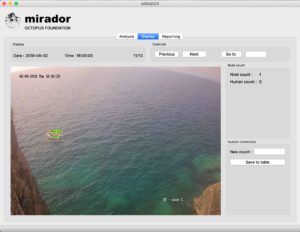 These images hold scientific potential to produce environmental statistics, such as human presence according to holidays, summer season etc. It would also be possible to list the various notable weather events, such as storms, droughts, and relate all of this data to the presence or the absence of monk seals at a specific location.
These images hold scientific potential to produce environmental statistics, such as human presence according to holidays, summer season etc. It would also be possible to list the various notable weather events, such as storms, droughts, and relate all of this data to the presence or the absence of monk seals at a specific location.
In order to help biologists and any other scientists to process such a great number of pictures, the Octopus Foundation is working on the development of a image recognition software based on artificial intelligence, in order to detect boats, divers and seals and automatically produce statistics.
Once tested and approved, this program will be freely available to any scientists that has chosen to build an autonomous monitoring kit for his or her project.
Dynamic monitoring
Thanks to the newly developed protocol of drone relay, tested in 2018 by the Octopus Foundation first in Switzerland and then in Greece (see page “Tools“), several monk seals were filmed in the vicinity of a marine cave.
The goal is to show the potential and utility of such devices in the study of marine mammals. These beautiful images also help raise the public’s awareness through documentaries for example.
“The odyssey of the Monk Seal” – 2021
This film was shot over four years by Thomas Delorme and the Octopus Foundation.
Monk seal mum protects newborn, Oct. 2022
New monk seal birth in the Ionian Islands, Oct. 2021
Happy new year from the monk seal family, Jan. 2021
Birth of baby monk seal in the Ionian Islands, Nov. 2020
Ianos Medicane, Sept. 2020
“The last seals of the Mediterranean” – 2019 GEO Magazine
In September of 2019, the website GEO Magazine published a video on the Octopus Foundation’s project to help the study of Mediterranean monk seals:
Password on Vimeo: PhoqueGrece2018
Design and set up of an autonomous monitoring kit, 2018
In order to photograph monk seal in their natural environment and collect scientific data related to their presence or absence (human pressure, number of boats, weather conditions etc) we designed a prototype of monitoring system, fully autonomous and connected.
The research and set up are explained in the following video:
Dynamic monitoring, 2018 (drone)
During the month of June, 2018, we were lucky enough to observe several Mediterranean monk seals swimming in their natural environment.
Both individuals filmed close to Greek island are adults. The images are analyzed by the species’ specialists in order to collect information about their behavior.
This experience allowed us to test and validate the effectiveness of relaying drones, in order to capture these stunning images of one of the most endangered marine mammals on the planet.
A new open source and DIY system to monitor coastal species !
After several years of prototype improvement and conclusive field testing, the Octopus Foundation team is proud to present the first version of the step-by-step manual to build your very own open source, autonomous and connected monitoring system. This kit was initially developed to study the elusive and rare Mediterranean Monk Seal. You can download the manual at the bottom of this page.
The objective is to allow marine biologist to build and install their own kits to monitor the marine caves of their region where they know specimens of seals can be found.
Technically, this system can and will be improved in the months and years to come. We decided to publish the details with no restrictions considering it already yielded fantastic results, from a biological perspective (precise identification of animals, calendar of presence and absence in caves) as well as from a potential human-pressure perspective. For instance, it is possible to have an hour by hour account of how many tourist boats moor in front of the inhabited marine caves.
Some of our systems have been on location for more than three consecutive years, and keep sending images and data. This proves that the chosen elements are capable of withstanding harsh conditions (high temperatures during the summer in the Mediterranean basin, and high levels of humidity in the winter months, etc). Furthermore, these elements were also chosen for their limited cost. A complete system will not cost more than 2’000 Euros*.
In order to assist those that should need a technical help to build one of these systems, the Octopus Foundation team will gladly offer any kind of support, even at a distance. We will for example provide the latest version of the software (Python script) that manages the kit, with specific parameters to each situation.
We hope that this open source monitoring kit might help as many marine biologists as possible to study the Mediterranean monk seal, and any other species (such as turtles that come to shore to lay their eggs for example), and that globally it will help to better understand these key species in order to better protect them.
* Up until February 2020, which was before the worldwide coronavirus epidemic. It might be possible that the cost of certain elements increases in the future






